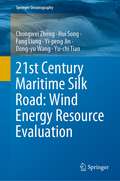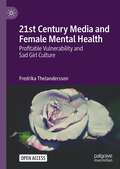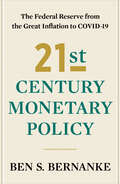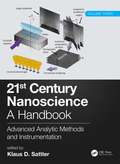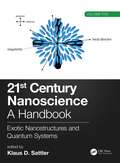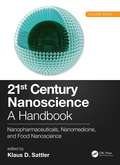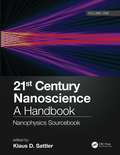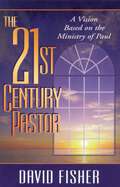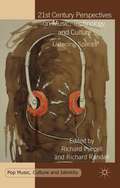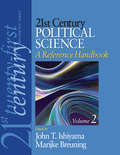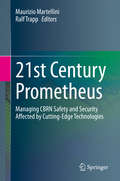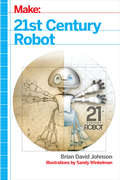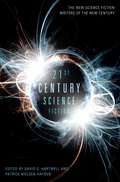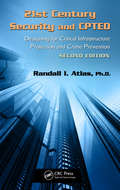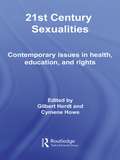- Table View
- List View
21st Century Maritime Silk Road: Wave Energy Resource Evaluation (Springer Oceanography)
by Qing Wang Chongwei Zheng Jianjun Xu Chao ZhanThis book focuses on the evaluation of wave energy in the Maritime Silk Road. Firstly, it compares wave energy and other main energy sources, and then discusses the various disadvantages. It also presents the current research and the difficulties of wave energy evaluation, and systematically analyzes the climatic characteristics of the wave energy, including the temporal–spatial distribution and climatic trend of a series of key factors (e.g. wave power density, availability, richness, stability, energy direction, energy storage). It then describes the design of a short-term forecasting scheme and a long-term projection scheme of wave energy suitable for the Maritime Silk Road, to serve as a plan for the daily operation and long-term development of wave energy. Further, it highlights the wave energy analysis and decision-making in the context of the remote islands and reefs, using Sri Lanka is taken as a case study. Lastly, it presents the first wave energy resource dataset for the Maritime Silk Road.This book is one of a series of publications on the 21st century Maritime Silk Road (shortened as “Maritime Silk Road”) that covers the characteristics of the marine environment and marine new energy, remote islands and reef construction, climate change, early warning of wave disasters, legal escort, marine environment and energy big data construction, contributing to the safe and efficient construction of the Maritime Silk Road. It aims to improve our knowledge of the ocean, and so improve the capacity for marine construction, enhance the viability of remote islands and reefs, ease the energy crisis and protect the ecological environment and improve the quality of life of residents along the Maritime Silk Road, as well as to protect the rights, and interests of the countries and regions participating in the construction of the Maritime Silk Road. This book is a valuable reference resource for decision-makers, researchers, and marine engineers working in the related fields.
21st Century Maritime Silk Road: Wind Energy Resource Evaluation (Springer Oceanography)
by Chongwei Zheng Hui Song Fang Liang Yi-peng Jin Dong-yu Wang Yu-chi TianThis book aims to establish a wind energy evaluation system, to provide scientific reference for site selection, daily operation and long-term planning of wind power generation, thus to make contribution to breaking the shackles of power shortage. Firstly, it presents the advantages and disadvantages of offshore wind power, then further discusses about the status quo and challenges for wind power programs along the Maritime Silk Road and offer suggestions. A wind energy evaluation system was proposed with the Maritime Silk Road as a case study, including climatic features of wind power (temporal-spatial distribution), long-term climatic trend and mechanism, short-term forecast of wind energy, mid- and long-term projection of wind energy, technology of wind energy evaluation on key point or vital region and offshore wind energy dataset construction, to provide systematic and scientific reference for wind power evaluation and utilization.This book is one of the series of publications on 21st century Maritime Silk Road (shortened as “Maritime Silk Road”). It covers the characteristics of the marine environment and marine renewable energy, remote islands and reefs construction, climate change, early warning of wave disasters, legal escort, marine environment and energy big data construction, etc., contributing to the safe and efficient construction of the Maritime Silk Road. It aims to improve our knowledge of the ocean, thus, to improve the capacity for marine construction, enhance the viability of remote islands and reefs, ease the energy crisis and protect the ecological environment, improve the quality of life of residents along the Maritime Silk Road, and protect the rights, interests of the countries and regions participating in the construction of the Maritime Silk Road. It is a valuable reference for decision-makers, researchers, and marine engineers working in the related fields.
21st Century Media and Female Mental Health: Profitable Vulnerability and Sad Girl Culture
by Fredrika ThelanderssonThis open access book examines the conversations around gendered mental health in contemporary Western media culture. While early 21st century-media was marked by a distinct focus on happiness, productivity and success, during the 2010s negative feelings and discussions around mental health have become increasingly common in that same media landscape. This book traces this turn to sadness in women’s media culture and shows that it emerged indirectly as a result of a culture overtly focused on happiness. By tracing the coverage of mental health issues in magazines, among female celebrities, and on social media this book shows how an increasingly intimate media environment has made way for a profitable vulnerability, that takes the shape of marketable and brand-friendly mental illness awareness that strengthens the authenticity of those who embrace it. But at the same time sad girl cultures are proliferating on social media platforms, creating radically honest spaces where those who suffer get support, and more capacious ways of feeling bad are formed. Using discourse analysis and digital ethnography to study contemporary representations of mental illness and sadness in Western popular media and social media, this book takes a feminist media studies approach to popular discourse, understanding the conversations happening around mental health in these sites to function as scripts for how to think about and experience mental illness and sadness
21st Century Monetary Policy: The Federal Reserve From The Great Inflation To Covid-19
by Ben S. Bernanke21st Century Monetary Policy takes readers inside the Federal Reserve, explaining what it does and why. In response to the COVID-19 pandemic, the Federal Reserve deployed an extraordinary range of policy tools that helped prevent the collapse of the financial system and the U.S. economy. Chair Jerome Powell and his colleagues lent directly to U.S. businesses, purchased trillions of dollars of government securities, pumped dollars into the international financial system, and crafted a new framework for monetary policy that emphasized job creation. These strategies would have astonished Powell’s late-20th-century predecessors, from William McChesney Martin to Alan Greenspan, and the advent of these tools raises new questions about the future landscape of economic policy. In 21st Century Monetary Policy, Ben S. Bernanke—former chair of the Federal Reserve and one of the world’s leading economists—explains the Fed’s evolution and speculates on its future. Taking a fresh look at the bank’s policymaking over the past seventy years, including his own time as chair, Bernanke shows how changes in the economy have driven the Fed’s innovations. He also lays out new challenges confronting the Fed, including the return of inflation, cryptocurrencies, increased risks of financial instability, and threats to its independence. Beyond explaining the central bank’s new policymaking tools, Bernanke also captures the drama of moments when so much hung on the Fed’s decisions, as well as the personalities and philosophies of those who led the institution.
21st Century Nanoscience - A Handbook: Advanced Analytic Methods and Instrumentation (Volume 3) (21st Century Nanoscience)
by Klaus D. SattlerThis up-to-date reference is the most comprehensive summary of the field of nanoscience and its applications. It begins with fundamental properties at the nanoscale and then goes well beyond into the practical aspects of the design, synthesis, and use of nanomaterials in various industries. It emphasizes the vast strides made in the field over the past decade – the chapters focus on new, promising directions as well as emerging theoretical and experimental methods. The contents incorporate experimental data and graphs where appropriate, as well as supporting tables and figures with a tutorial approach.
21st Century Nanoscience – A Handbook: Bioinspired Systems and Methods (Volume Seven) (21st Century Nanoscience)
by Klaus D. SattlerThis 21st Century Nanoscience Handbook will be the most comprehensive, up-to-date large reference work for the field of nanoscience. Handbook of Nanophysics by the same editor published in the fall of 2010 and was embraced as the first comprehensive reference to consider both fundamental and applied aspects of nanophysics. This follow-up project has been conceived as a necessary expansion and full update that considers the significant advances made in the field since 2010. It goes well beyond the physics as warranted by recent developments in the field. This seventh volume in a ten-volume set covers bioinspired systems and methods. Key Features: Provides the most comprehensive, up-to-date large reference work for the field. Chapters written by international experts in the field. Emphasises presentation and real results and applications. This handbook distinguishes itself from other works by its breadth of coverage, readability and timely topics. The intended readership is very broad, from students and instructors to engineers, physicists, chemists, biologists, biomedical researchers, industry professionals, governmental scientists, and others whose work is impacted by nanotechnology. It will be an indispensable resource in academic, government, and industry libraries worldwide. The fields impacted by nanophysics extend from materials science and engineering to biotechnology, biomedical engineering, medicine, electrical engineering, pharmaceutical science, computer technology, aerospace engineering, mechanical engineering, food science, and beyond.
21st Century Nanoscience – A Handbook: Design Strategies for Synthesis and Fabrication (Volume Two) (21st Century Nanoscience)
by Klaus D. SattlerThis up-to-date reference is the most comprehensive summary of the field of nanoscience and its applications. It begins with fundamental properties at the nanoscale and then goes well beyond into the practical aspects of the design, synthesis, and use of nanomaterials in various industries. It emphasizes the vast strides made in the field over the past decade – the chapters focus on new, promising directions as well as emerging theoretical and experimental methods. The contents incorporate experimental data and graphs where appropriate, as well as supporting tables and figures with a tutorial approach.
21st Century Nanoscience – A Handbook: Exotic Nanostructures and Quantum Systems (Volume Five) (21st Century Nanoscience)
by Klaus D. SattlerThis 21st Century Nanoscience Handbook will be the most comprehensive, up-to-date large reference work for the field of nanoscience. Handbook of Nanophysics, by the same editor, published in the fall of 2010, embraced as the first comprehensive reference to consider both fundamental and applied aspects of nanophysics. This follow-up project has been conceived as a necessary expansion and full update that considers the significant advances made in the field since 2010. It goes well beyond the physics as warranted by recent developments in the field. The fifth volume in a ten-volume set covers exotic nanostructures and quantum systems. Key Features: Provides the most comprehensive, up-to-date large reference work for the field. Chapters written by international experts in the field. Emphasises presentation and real results and applications. This handbook distinguishes itself from other works by its breadth of coverage, readability and timely topics. The intended readership is very broad, from students and instructors to engineers, physicists, chemists, biologists, biomedical researchers, industry professionals, governmental scientists, and others whose work is impacted by nanotechnology. It will be an indispensable resource in academic, government, and industry libraries worldwide. The fields impacted by nanoscience extend from materials science and engineering to biotechnology, biomedical engineering, medicine, electrical engineering, pharmaceutical science, computer technology, aerospace engineering, mechanical engineering, food science, and beyond.
21st Century Nanoscience – A Handbook: Industrial Applications (Volume Nine) (21st Century Nanoscience)
by Klaus D. SattlerThis 21st Century Nanoscience Handbook will be the most comprehensive, up-to-date large reference work for the field of nanoscience. Handbook of Nanophysics by the same editor published in the fall of 2010 and was embraced as the first comprehensive reference to consider both fundamental and applied aspects of nanophysics. This follow-up project has been conceived as a necessary expansion and full update that considers the significant advances made in the field since 2010. It goes well beyond the physics as warranted by recent developments in the field. This ninth volume in a ten-volume set covers industiral applications. Key Features: Provides the most comprehensive, up-to-date large reference work for the field. Chapters written by international experts in the field. Emphasises presentation and real results and applications. This handbook distinguishes itself from other works by its breadth of coverage, readability and timely topics. The intended readership is very broad, from students and instructors to engineers, physicists, chemists, biologists, biomedical researchers, industry professionals, governmental scientists, and others whose work is impacted by nanotechnology. It will be an indispensable resource in academic, government, and industry libraries worldwide. The fields impacted by nanophysics extend from materials science and engineering to biotechnology, biomedical engineering, medicine, electrical engineering, pharmaceutical science, computer technology, aerospace engineering, mechanical engineering, food science, and beyond.
21st Century Nanoscience – A Handbook: Low-Dimensional Materials and Morphologies (Volume Four) (21st Century Nanoscience)
by Klaus D. Sattler21st Century Nanoscience - A Handbook: Low-Dimensional Materials and Morphologies (Volume 4) will be the most comprehensive, up-to-date large reference work for the field of nanoscience. Handbook of Nanophysics by the same editor published in the fall of 2010 and was embraced as the first comprehensive reference to consider both fundamental and applied aspects of nanophysics. This follow-up project has been conceived as a necessary expansion and full update that considers the significant advances made in the field since 2010. It goes well beyond the physics as warranted by recent developments in the field. This fourth volume in a ten-volume set covers low-dimensional materials and morphologies. Key Features: Provides the most comprehensive, up-to-date large reference work for the field. Chapters written by international experts in the field. Emphasises presentation and real results and applications. This handbook distinguishes itself from other works by its breadth of coverage, readability and timely topics. The intended readership is very broad, from students and instructors to engineers, physicists, chemists, biologists, biomedical researchers, industry professionals, governmental scientists, and others whose work is impacted by nanotechnology. It will be an indispensable resource in academic, government, and industry libraries worldwide. The fields impacted by nanophysics extend from materials science and engineering to biotechnology, biomedical engineering, medicine, electrical engineering, pharmaceutical science, computer technology, aerospace engineering, mechanical engineering, food science, and beyond.
21st Century Nanoscience – A Handbook: Nanopharmaceuticals, Nanomedicine, and Food Nanoscience (Volume Eight) (21st Century Nanoscience)
by Klaus D. SattlerThis 21st Century Nanoscience Handbook will be the most comprehensive, up-to-date large reference work for the field of nanoscience. Handbook of Nanophysics by the same editor published in the fall of 2010 and was embraced as the first comprehensive reference to consider both fundamental and applied aspects of nanophysics. This follow-up project has been conceived as a necessary expansion and full update that considers the significant advances made in the field since 2010. It goes well beyond the physics as warranted by recent developments in the field. This eighth volume in a ten-volume set covers nanopharmaceuticals, nanomedicine, and food nanoscience. Key Features: Provides the most comprehensive, up-to-date large reference work for the field. Chapters written by international experts in the field. Emphasises presentation and real results and applications. This handbook distinguishes itself from other works by its breadth of coverage, readability and timely topics. The intended readership is very broad, from students and instructors to engineers, physicists, chemists, biologists, biomedical researchers, industry professionals, governmental scientists, and others whose work is impacted by nanotechnology. It will be an indispensable resource in academic, government, and industry libraries worldwide. The fields impacted by nanophysics extend from materials science and engineering to biotechnology, biomedical engineering, medicine, electrical engineering, pharmaceutical science, computer technology, aerospace engineering, mechanical engineering, food science, and beyond.
21st Century Nanoscience – A Handbook: Nanophotonics, Nanoelectronics, and Nanoplasmonics (Volume Six) (21st Century Nanoscience)
by Klaus D. Sattler21st Century Nanoscience - A Handbook: Nanophotonics, Nanoelectronics, and Nanoplasmonics (Volume 6) will be the most comprehensive, up-to-date large reference work for the field of nanoscience. Handbook of Nanophysics by the same editor published in the fall of 2010 and was embraced as the first comprehensive reference to consider both fundamental and applied aspects of nanophysics. This follow-up project has been conceived as a necessary expansion and full update that considers the significant advances made in the field since 2010. It goes well beyond the physics as warranted by recent developments in the field. This sixth volume in a ten-volume set covers nanophotonics, nanoelectronics, and nanoplasmonics. Key Features: Provides the most comprehensive, up-to-date large reference work for the field. Chapters written by international experts in the field. Emphasises presentation and real results and applications. This handbook distinguishes itself from other works by its breadth of coverage, readability and timely topics. The intended readership is very broad, from students and instructors to engineers, physicists, chemists, biologists, biomedical researchers, industry professionals, governmental scientists, and others whose work is impacted by nanotechnology. It will be an indispensable resource in academic, government, and industry libraries worldwide. The fields impacted by nanophysics extend from materials science and engineering to biotechnology, biomedical engineering, medicine, electrical engineering, pharmaceutical science, computer technology, aerospace engineering, mechanical engineering, food science, and beyond.
21st Century Nanoscience – A Handbook: Nanophysics Sourcebook (Volume One) (21st Century Nanoscience)
by Klaus D. SattlerThis up-to-date reference is the most comprehensive summary of the field of nanoscience and its applications. It begins with fundamental properties at the nanoscale and then goes well beyond into the practical aspects of the design, synthesis, and use of nanomaterials in various industries. It emphasizes the vast strides made in the field over the past decade – the chapters focus on new, promising directions as well as emerging theoretical and experimental methods. The contents incorporate experimental data and graphs where appropriate, as well as supporting tables and figures with a tutorial approach.
21st Century Nanoscience – A Handbook: Public Policy, Education, and Global Trends (Volume Ten) (21st Century Nanoscience)
by Klaus D. SattlerThis up-to-date reference is the most comprehensive summary of the field of nanoscience and its applications. It begins with fundamental properties at the nanoscale and then goes well beyond into the practical aspects of the design, synthesis, and use of nanomaterials in various industries.
21st Century Paradigm Change in Performance and Design Metrics: Proceedings Of A Workshop
by Engineering Medicine National Academies of SciencesIn September 2015, the National Academies of Sciences, Engineering, and Medicine convened a two-day workshop on evolving paradigms for design and manufacturing. Participants discussed ways to lower costs and shorten production time in defense systems while bringing materials and manufacturing alternatives into the tradespace. This publication summarizes the presentations and discussions from the workshop.
21st Century Pastor: A Vision Based on the Ministry of Paul
by David C. FisherThe third millennium. It's a time of tremendous opportunity for the church--and tremendous challenge. More than ever, pastors need a model for ministry that can equip them for the rigors of a restless, increasingly secularized culture. In the 21st Century Pastor, David Fisher explores the apostle Paul's concept of ministry to offer a paradigm that is both biblical and relevant. Paul's view is fleshed out with examples from Fisher's own twenty-five years of pastoral experience, presenting a roadmap for today's pastor that is scholarly, practical, dynamic, and inspiring. The 21st Century Pastor first addressees crucial issues of pastoral identity, the significance of geography, time, and ecclesiology. It then explores Paul's metaphors for ministry (jars of clay, farmers and builders, servants and stewards, and others) to reveal an accurate portrait of an effective, biblical pastor--the kind who will speak to the heart of modern culture rather than languish on its fringes. Filling the rare role of a pastor to pastors, Fisher's sage insights help pastors answer their own identity questions, empowering them to minister to a deeply needy society. Says Fisher, "Pastors who know what time it is will, in the name and power of God, create communities of faith where the values of the Gospel are embraced, taught, and lived out."
21st Century Perspectives on Music, Technology, and Culture: Listening Spaces
by Richard PurcellThis collection examines the multiple ways people listen to, consume, and produce music and sound in an increasingly digital world. Technologies such as social networks, recommendation algorithms, virtual cloud storage, and portable listening devices increasingly mediate both personal and communal experiences with music. While such technologies may be convenient, their unexamined use raises ethical, socio-political, and philosophical questions. This volume brings together multiple contributions which engage with these questions and others posed by emergent musical and social technologies. Drawing upon a range of different areas of inquiry, it provides a varied critical approach to the question of how people interact with music in the modern era and debates the universal themes of modern music consumption.
21st Century Political Science: A Reference Handbook
by John T. Ishiyama Marijke BreuningRequest a free trial of SAGE Knowledge to sample this title and many more! www.sagepub.com/freetrial Via 99 entries or "mini-chapters," the SAGE 21st Century Reference Series volumes on political science highlight the most important topics, issues, questions, and debates any student obtaining a degree in this field ought to have mastered for effectiveness in the 21st century. 21st Century Political Science: A Reference Handbook serves as an authoritative reference source that meets students' research needs with more detailed information than encyclopedia entries but not so much jargon, detail, or density as a journal article or a research handbook chapter. An editorial advisory board comprised of eminent scholars from various subfields, many of whom are also award-winning teachers, selected the most important general topics in the discipline. The two volumes are divided into six major parts: 1) General Approaches of Political Science; 2) Comparative Politics; 3) International Relations; 4) Political Science Methodology; 5) Political Thought; and 6) American Politics. A section on identity politics includes chapters on topics such as Race, Ethnicity, and Politics; Gender and Politics; Religion and Politics; and LGBT Issues/ Queer Theory. This two-volume resource makes fairly complex approaches in political science accessible to advanced undergraduate and beginning graduate students.
21st Century Populism
by George Serafeim David FreibergWhile the first decade of the 21st century saw a massive financial crisis that led to significant economic downturn, the second decade saw the rise of political leaders, who built their support upon a political message that championed the common person against the collective enemy—the political and economic elite. Historically, waves of populism were infrequent and occurred almost exclusively in developing nations. However, not seen since the pre-World War II years had populist leaders gained such a following throughout the developed world—in countries with the strongest democracies. Driven heavily by growing inequality and degrading trust in institutions, populist leaders took global elections by storm. Populist movements raised the fundamental question of the role of business in the development of the conditions for the genesis of these movements, especially in relation to inequality, and how business would respond to subsequent government interventions that reduced the freedom of markets.
21st Century Prometheus: Managing CBRN Safety and Security Affected by Cutting-Edge Technologies
by Maurizio Martellini Ralf TrappThis book describes the evolving CBRN risk landscape and highlights advances in the “core” CBRN technologies, including when combined with (improvised) explosive devices (CBRNe threats). It analyses how associated technologies create new safety and security risks, challenging certain assumptions that underlie current control regimes. The book also shows how technologies can be enablers for more effective strategies to mitigate these risks.21st-century safety and security risks emanating from chemical, biological, radiological and nuclear materials – whether resulting from natural events, accidents or malevolent use - are increasingly shaped by technologies that enable their development, production or use in ways that differ from the past. Artificial intelligence, the use of cyberspace, the revolution in the life sciences, new manufacturing methods, new platforms and equipment for agent delivery, hypersonic weapons systems, information tools utilised in hybrid warfare – these and other technologies are reshaping the global security environment and CBRN landscape. They are leading to a growing potential for highly targeted violence, and they can lead to greater instability and vulnerability worldwide. At the same time, technology offers solutions to manage CBRN risks. Examples are faster detection, more accurate characterisation of the nature and origin of CBRN agents, new forensic investigation methods, or new medical treatments for victims of CBRN incidents. New educational concepts help to foster a culture of responsibility in science and technology and strengthen governance. New training methods help develop practical skills to manage CBRN risks more effectively.The book concludes that there is a growing need for a holistic framework towards CBRN risk mitigation. Traditional arms control mechanisms such as global, regional or bilateral treaties and export controls are still needed, as they provide a necessary legal and institutional framework. But laws and technology denial alone will not suffice, and institutional mechanisms can at times be weak. Given the pace of technological progress and the diffusion of critical knowledge, tools and materials, policymakers must accept that CBRN risks cannot be eliminated altogether. Instead, society has to learn to manage these risks and develop resilience against them. This requires a “softer”, broadly based multi-stakeholder approach involving governments, industry, the research and development communities, educators, and civil society. Furthermore, educating policymakers that cutting-edge technologies may seriously affect global strategic stability could create incentives for developing a more creative and contemporary arms control strategy that fosters cooperation rather than incremental polarisation.
21st Century Research on Drugs and Ethnicity: Studies Supported by the National Institute on Drug Abuse
by Peter L. MyersLearn about the latest federally supported research on ethnicity and drug use The National Institute on Drug Abuse has supported professional research into variation among ethnic groups&’ use, abuse, and recovery from alcohol, tobacco, and other drugs, as well as research into perceptions of and readiness for treatment. 21st Century Research on Drugs and Ethnicity: Studies Supported by the National Institute on Drug Abuse takes a detailed look at the research performed in the last three years to help provide evidence-based and culturally competent counseling and treatment for individuals suffering from substance abuse/addiction syndromes. Top researchers discuss crucial unique issues in ethnic group use of psychoactive substances. This valuable resource explores the studies to better enable treatment, counseling, and prevention personnel who work in treatment programs, community groups, and schools to provide effective evidence-based practices tailored to the population they serve. 21st Century Research on Drugs and Ethnicity: Studies Supported by the National Institute on Drug Abuse presents prominent researchers such as J. Scott Tonigan, William Miller, and Mario de la Rosa who reveal and discuss the latest important data. This volume can be used by practitioners to increase the rates of individuals making healthy choices, or recovering from and sustaining recovery from abuse syndromes. The book also includes an introduction by Lula Beatty, PhD, Chief of the Special Populations Office at the National Institute on Drug Abuse. Topics discussed in 21st Century Research on Drugs and Ethnicity: Studies Supported by the National Institute on Drug Abuse include: a comparison of professional models of treatment readiness analysis of how client culture matches treatment culture Native American client response to modern treatment modalities research on current rates of drug use among racial/ethnic groups at colleges study into injecting drug use behaviors problems of treatment underutilization by Latinos/Latinas and much more! 21st Century Research on Drugs and Ethnicity: Studies Supported by the National Institute on Drug Abuse is a valuable resource for human service workers, psychologists, social workers, addictions researchers, educators, trainers, treatment personnel, and graduate students in counseling, social work, health, and addictions.
21st Century Robot: The Dr. Simon Egerton Stories
by Brian David Johnson Sandy WinkelmanWhen companies develop a new technology, do they ask how it might affect the people who will actually use it? That, more or less, sums up Brian David Johnson’s duties as Intel’s futurist-in-residence. In this fascinating book, Johnson provides a collection of science fiction prototyping stories that attempt to answer the question.These stories focus on the same theme: scientists and thinkers exploring personal robotics as a new form of artificial intelligence. This isn’t fanciful speculation. Johnson’s stories are based on Intel’s futurecasting research, which uses ethnographic field studies, technology research, trend data, and science fiction to develop a pragmatic vision of consumers and computing. 21st Century Robot presents science fiction designed to bring about science fact.Get real insight into technology and the future with this book. It will open your eyes.
21st Century Science Fiction
by David G. Hartwell Patrick Nielsen HaydenA fantastic collection of recent stories from some of science fiction's greatest up-and-coming authors, including many award-winners.David Hartwell and Patrick Nielsen Hayden have long been recognised as some of the most skilled and trusted arbiters in science fiction, but Twenty-First Century Science Fiction presents fans with a first opportunity to see their considerable talents combined, and also to get a unique perspective on what's coming next in the genre. The anthology includes authors ranging from bestselling and established favourites to incandescent new talents, including Cory Doctorow, Catherynne M. Valente, John Scalzi, Jo Walton, Charles Stross, Elizabeth Bear and Peter Watts. The stories selected include winners and nominees of all of the science fiction genre's major awards.Stories include Bacigalupi's 'The Gambler' (Hugo, Nebula, Sturgeon and BSFA nominee), Bear's 'Tideline' (Hugo and Sturgeon winner), Cooper's 'Savant Songs' (Sturgeon nominee), Cornell's 'One of Our Bastards Is Missing' (Hugo nominee), Gregory's 'Second Person Present Tense' (Sturgeon nominee), Mary Robinette Kowal's 'Evil Robot Monkey' (Hugo nominee), David Levine's 'Tk'tk'tk' (Hugo winner), David Moles's 'Finisterra' (Hugo nominee, Sturgeon winner), Hannu Rajaniemi's 'His Master's Voice' (BSFA and Sturgeon winner), Rachel Swirsky's 'Eros', Philia, Agape (Hugo and Sturgeon nominee), Peter Watts's 'The Island' (Hugo winner, Sturgeon nominee).
21st Century Security and CPTED: Designing for Critical Infrastructure Protection and Crime Prevention, Second Edition
by Randall I. AtlasThe concept of Crime Prevention Through Environmental Design (CPTED) has undergone dramatic changes over the last several decades since C. Ray Jeffery coined the term in the early 1970s, and Tim Crowe wrote the first CPTED applications book. The second edition of 21st Century Security and CPTED includes the latest theory, knowledge, and practice of
21st Century Sexualities: Contemporary Issues in Health, Education, and Rights
by Gilbert Herdt Cymene HoweExploring sexuality in the twenty-first century, this unique book collects together more than fifty timely and accessible contributions to create a wide-ranging and compelling picture of contemporary American sexuality. Incorporating the latest cutting-edge controversies, theory and methodological material from the major domains of sexual education, sexual health, sexual rights, and globalization, this book includes a superb editorial overview that opens up the field for students and teachers alike. This anthology will be an invaluable supplement to all levels of students and researchers interested in sexuality across a range of disciplines, including anthropology, sociology, gender and sexuality studies and politics.

